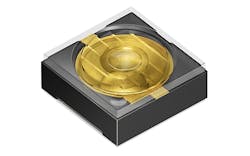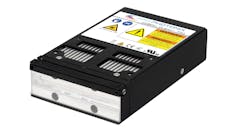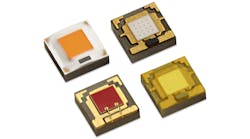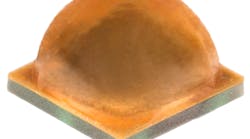Biometric identification, color projectors, and TVs with a richer color gamut are the targets of new packaged LED technology from Osram Opto Semiconductors.
Osram Opto Semiconductors has announced new infrared (IR) LEDs for iris-scanning applications and a new high-power RGB LED family for projectors. Moreover, the company has released preliminary information about plans to ship an LED with quantum dots (QDs) taking the place of green phosphor on a packaged LED intended for display and TV backlighting applications, promising a richer color gamut.
Interested in more articles & announcements on packaged LEDs?
Device security
The Oslux SFH 4786S IR LED (Osram calls them IREDs) squarely targets biometric identification applications in devices such as smartphones and tablets. Iris scanning allows owners of a device to simply gain access while sensitive data is protected from others. The new products are follow-on components to IR LEDs that the company announced one year ago.
Both the new packaged LEDs and the prior SFH 4780S family are optimized for light extraction that is necessary for generating an iris image that can be acquired by the camera in a phone or tablet. But the new SFH 4786S is lower profile, measuring 1.6-mm high whereas the prior product was 2.4-mm high. The more compact design enables usage in thinner phones and tablets.
The new LED also features an 8° tilt in the emission direction. Osram says the "slightly sideways" beam matches the typical field of view of a camera in terms of how users hold such devices. "Up to now, mechanical means have been used in iris scanners to tilt the IRED slightly," said Chris Goeltner, IR product marketing manager at Osram. "However, this additional expense is no longer needed with the SFH 4786S. This greatly reduces the level of complexity in designing iris scanners."
Projector applications
For the projector space, Osram has released a new LED in the Ostar Projection Power family. The company said the new packaged LEDs will enable mainstream projectors to output 2500 lm. The company offers monochromatic red and blue, and phosphor-converted green LEDs in the family for the intended RGB application.
Each of the LEDs integrates six emitters with an area of 2 mm2. The devices are based on the Osram UX:3 thin-film technology platform. As we covered in an article on color LEDs, UX:3 ensures uniform current spreading, enabling the high output required in applications such as projectors. The red LED is rated at 4500 lm, the green at 11,000 lm, and the blue at 33W of radiometric power.
Optimizing color gamut
The previews of the Quantum Colors QD-based packaged LEDs, due next year, could impact both the computer-display and TV backlighting applications. Such displays are limited in terms of the colors that can be accurately reproduced by the amount of red, green, and blue energy in the backlight.
Indeed, many high-end LED-backlit, LCD TVs today are using QD technology because of the ability of QDs to deliver rich colors. We covered the application in a 2013 feature article. But most of the QD-enabled displays rely on a sheet that is applied to the back of the LCD with the QDs applied on that sheet, and that adds manufacturing costs.
Osram intends to apply the QDs directly to LEDs, thus allowing the technology to be used with manufacturing techniques that are in widespread usage with mainstream TVs. The company said that the LED approach would halve the cost of adding QDs in a 55-in. TV.
Ironically, the Osram announcement indicates that the QDs will only be used in the green color space while phosphor is still used for the red color conversion. It's often the red colors in the gamut that prove problematic for LED-backlit displays to reproduce accurately. But Osram said its approach covers the color space effectively and that partners will launch products using the LEDs in 2016.
The company is also touting that the implementation is cadmium free. Osram said the development of the Quantum Colors technology was in part enabled by the SSL4EU and Hi-Q-LED projects funded by the European Union and the German Ministry of Education and Research (BMBF). Osram also has a joint-development agreement with Nanoco focused on cadmium-free QDs that was just renewed. But an Osram spokesperson would not confirm whether or not Nanoco was directly involved with Qauntum Colors.
We have seen at least one other recent story about methods to improve display color performance using novel LED concepts. In the "Tech Toys" article that is in our November/December issue, we included new Apple Retina PC displays that use what Apple calls a red-green-phosphor LED that presumably delivers richer reds because of the phosphor composition.








